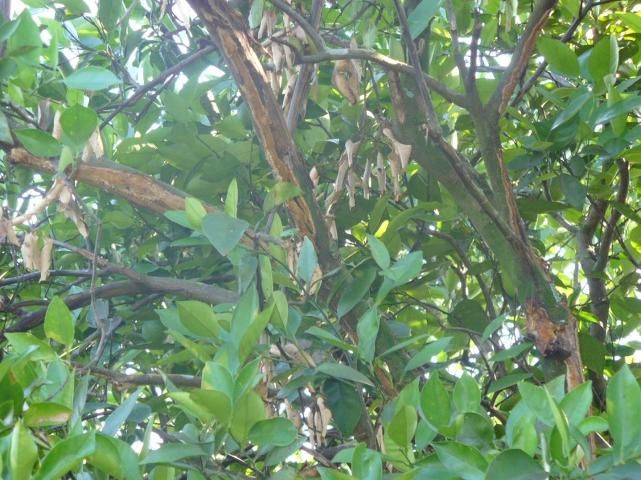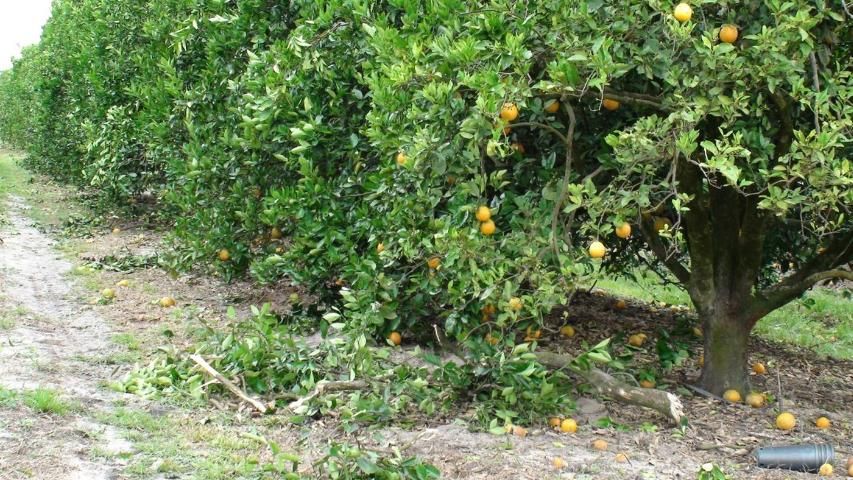Analyzing Production Records of Commercial Sweet Orange Blocks to Measure Effects of Mechanical Harvesting on Long-Term Production and Tree Health
Mechanical Harvesting
Field observations between 2000 and 2004 documented that trunk and canopy shakers with catch frames could improve harvest labor productivity by tenfold and reduce harvest costs by 20 to 30 cents per box. Depending on fruit yield, these cost reductions translate into an increase in net returns of amounts ranging from $80 to $150 per acre (Roka et al. 2009). Despite lower harvest costs, growers have not embraced mechanical harvesting mainly because of the visible injuries inflicted on trees by trunk and canopy shakers. These injuries are largely superficial—removal of leaves and flowers, exposure of roots, bark scuffs (Figure 1). Occasionally larger scaffold limbs are broken (Figure 2). Growers see any tree damage and worry that the health and future productivity of their trees may have been compromised. Before growers fully accept mechanical harvesting, they will have to be assured that any short-term financial benefits are not offset by long-term losses due to yield and or tree decline.

A study was undertaken in 2010 to analyze grower production data and compare whether mechanical harvesting had an adverse effect on fruit yield or shortened tree longevity as compared to hand harvesting. The purpose of this article is to describe how the study was organized and to summarize its results and conclusions.
Ever since mechanical harvesting systems were introduced in the 1960s, growers expressed serious concerns over the potential negative impact mechanical harvesting could have on their trees. Several multiyear studies, some dating back to the 1960s, have been conducted by University of Florida Institute of Food and Agricultural Sciences (UF/IFAS), United States Department of Agriculture Agricultural Research Service (USDA/ARS), and Florida Department of Citrus (FDOC) horticultural and engineering scientists to investigate whether the visible damage left by mechanical harvesting equipment caused any long-term harm to fruit production and tree survival. So long as harvesting takes place prior to the late-season Valencia period (May and June), these studies concluded that mechanical harvesting had no effect on fruit yields or tree mortality (Hedden, Churchill, and Whitney 1988; Whitney, Churchill, and Hedden 1986). More recent field experiments studied the impact of mechanical harvesting on various aspects of tree physiology (Li and Syvertsen 2005). Again, the central conclusion of this research was that well-nourished citrus trees withstood the stresses imposed by mechanical-harvesting equipment.

Credit: Barbara Hyman, UF/IFAS
Growers, however, remain skeptical of mechanical harvesting, and several reasons could explain their reluctance. First, all previous studies were designed as small-plot field trials and conducted under relatively controlled conditions that do not exactly reproduce commercial production conditions. Second, structural damage to scaffold limbs may be more serious than it appears and may not be easily assessed in small-scale studies. Third, the previous field trials lasted at most four years. Growers expect their trees to produce for at least twenty years, and most of a tree's economic value is not realized until after its twelfth season. The fact that a tree remains viable after four years will not reassure growers who wonder whether their trees can handle 10 to 15 consecutive years of mechanical harvesting.

Credit: Barbara Hyman, UF/IFAS
This article summarizes the results from a study undertaken in 2010 to address grower concerns about mechanical harvesting and tree health from a different angle. Instead of designing a horticultural field experiment, data were collected directly from the production records of commercial groves that used both mechanical and hand- crews to harvest oranges. Changes in annual fruit production (boxes per acre) from commercial groves in southwest Florida were analyzed with respect to harvest method (mechanical or hand) and the duration of mechanical harvesting (number of years). Regression techniques were applied to the yield data to determine whether the harvest method had a statistically significant effect on annual fruit production, and if so, to what extent. Other variables that could affect production were considered in the analysis (Table 1), including Hurricane Wilma, which blew through southwest Florida in fall 2005. A total of 572 observations were recorded, with 25,553 net tree acres represented. From 1999 to 2008, more than 11 million boxes were both mechanically and hand harvested from the blocks analyzed in this study. A total of 44 percent of all blocks harvested between 1999 and 2008 were mechanically harvested, of which 8 blocks were mechanically harvested each year and 14 blocks were harvested exclusively by hand. A more detailed description of the data and analysis methods can be found in Mosley, House, and Roka (2012).
The statistical analysis estimated whether various factors had a significant effect on per-acre fruit yields and to what extent these factors influenced yields. The "intercept" term listed in Table 2 captures the average per-acre yield of Valencia orange trees grafted onto Carrizo rootstocks. As expected, the regression model indicated that early oranges (i.e., Hamlin) produced more yield than did Valencia oranges, and specifically estimated the difference to be as much as 133 more boxes per acre for Hamlin oranges (Table 2). The coefficient for the hurricane variable was statistically significant and indicated that average yields after 2005 (i.e., post-hurricane) were nearly 135 boxes per acre less than yields during the years prior to Hurricane Wilma.
The factors of most interest to this study were the variables related to harvesting. Harvest Method distinguished between blocks that were mechanically and hand harvested during the current year. The fact that the harvest method in the current year had no effect on yield was reasonable because fruit set occurred 9–15 months before harvesting depending on whether the trees were early or late varieties, respectively. Lagged Harvest captured the effect on yield from how the trees were harvested during the prior season. Total Mechanical, the cumulative number of years over which specific blocks were mechanically harvested, attempted to capture long-term effects of sustained mechanical harvesting on per-acre yields. The positive coefficient on lagged harvest suggested that yields actually increased by nearly 10 boxes per acre in the next season. For total mechanical, the negative coefficient suggested that average yield declined by two boxes per acre for every year of mechanical harvesting. However, neither result was statistically significant. The data analyzed in this study did not support the concerns by growers that mechanical harvesting adversely affects tree yields.
Since 2004, the cost of growing sweet oranges for juice processing in Florida has increased from $800 to more than $1,700 per acre (Muraro 2009). Most of this cost increase is attributable to combating citrus greening (HLB), because growers have increased their use of pesticides to control the Asian citrus psyllid, the vector of HLB. In addition, the cost of harvesting fruit has increased by more than 30 percent because of higher minimum wages and recruitment of foreign agricultural guest workers through the H-2A program.
While some of these cost increases can be offset by the mechanical harvesting systems that are currently available, growers want to be assured that the long-term health of their trees will not be compromised. The analysis of grower production records confirmed the conclusions of previous experimental field trials that mechanical harvesting does not adversely affect production or tree health. An important caveat, however, remains—citrus trees need to be well-nourished both before and after mechanical harvesting. Unfortunately, the spread of citrus greening (HLB) since 2006 has made it impossible to presume that any citrus tree in Florida is well-nourished. Therefore, grower concerns toward mechanical harvesting remain and, as a result, the number of mechanically harvested acres has been falling rapidly since 2008 (FDOC 2012).
Long-term sustainability of the Florida citrus industry requires that tree health must be restored and average production across the citrus industry returned to at least its historic levels of between 400 and 500 boxes per acre. Once their groves are healthy, growers may again embrace mechanical harvesting without worrying about adversely affecting the health and long-term viability of their trees.
References
Hedden, S.L., D.B. Churchill, and J.D. Whitney. 1988. Trunk shakers for citrus harvesting–part II: Tree growth, fruit yield and removal. Applied Engineering in Agriculture 4:102–106.
Li, K-T., and J.P. Syvertsen. 2005. Mechanical harvesting has little effect on water status and leaf gas exchange in citrus trees. Journal of American Horticultural Sciences 130(5):661–666.
Mosley, K.R., L.A. House, and F.M. Roka. 2012. Adoption of mechanical harvesting for sweet orange trees in Florida: Addressing grower concerns on long-term impacts. International Food and Agribusiness Management Review 15(2):83–98.
Muraro, R. 2009. Southwest Florida summary budget costs, 2008–09. Citrus Research and Education Center, University of Florida, Lake Alfred, FL. http://www.crec.ifas.ufl.edu/extension/economics/pdf/SW_Budget_Summ_2008-2009.pdf.
Roka, F.M., J.K. Burns, J.P. Syvertsen, T. Spann, and B.R. Hyman. 2009. Improving the economic viability of Florida citrus by mechanical harvesting with the abscission agent CMNP. http://citrusmh.ifas.ufl.edu/pdf/db/abscission_white_paper_040609.pdf.
Whitney, J., D. Churchill, and S. Hedden. 1986. A five-year study of orange removal with trunk shakers. Proceedings of the Florida State Horticultural Society 109:40–44.


